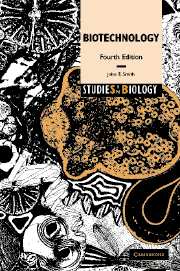Book contents
- Frontmatter
- Contents
- Preface
- 1 The nature of biotechnology
- 2 Substrates for biotechnology
- 3 Genetics and biotechnology
- 4 Bioprocess/fermentation technology
- 5 Enzyme technology
- 6 Biological fuel generation
- 7 Single cell protein (SCP)
- 8 Biotechnology and medicine
- 9 Environmental biotechnology
- 10 Biotechnology in the agricultural and forestry industries
- 11 Food and beverage biotechnology
- 12 Protection of biotechnological inventions
- 13 Safety in biotechnology
- 14 Public perception of biotechnology: genetic engineering – safety, social, moral and ethical considerations
- 15 Looking to the future
- Glossary
- Further reading
- Index
10 - Biotechnology in the agricultural and forestry industries
Published online by Cambridge University Press: 05 June 2012
- Frontmatter
- Contents
- Preface
- 1 The nature of biotechnology
- 2 Substrates for biotechnology
- 3 Genetics and biotechnology
- 4 Bioprocess/fermentation technology
- 5 Enzyme technology
- 6 Biological fuel generation
- 7 Single cell protein (SCP)
- 8 Biotechnology and medicine
- 9 Environmental biotechnology
- 10 Biotechnology in the agricultural and forestry industries
- 11 Food and beverage biotechnology
- 12 Protection of biotechnological inventions
- 13 Safety in biotechnology
- 14 Public perception of biotechnology: genetic engineering – safety, social, moral and ethical considerations
- 15 Looking to the future
- Glossary
- Further reading
- Index
Summary
Introduction
Globally, agriculture and food production are challenged to produce, in a sustainable way, sufficient, healthy and safe food for the further growing world population. It is estimated that nearly eight billion people will be living on this planet by 2020, with 3.5 billion living in urban areas. To feed this world population there will need to be substantial increases in the production of the staple food commodities, namely cereals (40% increase), meat (63%) and roots and tubers (40%). At least 80% of this food will need to be produced in developing countries, yet only about 6% of new virgin soil can be brought into cultivation. Mankind must, somehow, raise yields from areas planted with cereals (two-thirds of all energy in the human diet) to approximately double the present value. Consequently, there can be no alternative other than to plan, with modern scientific inputs, new agricultural systems that are sustainable yet intensive. Whereas in the last great ‘green revolution’ in agriculture in the 1960s to 1970s, the environment was adapted to the plant by increased use of fertilisers, biocides, irrigation, etc., modern sustainable agriculture must increasingly adapt the plant to the environment, breeding high-yielding crops that can grow in places deficient in nitrogen or water, and where plant diseases and pests prevail. Many aspects of modern biotechnology are, and will increasingly be, applied to agriculture.
- Type
- Chapter
- Information
- Biotechnology , pp. 181 - 203Publisher: Cambridge University PressPrint publication year: 2004



